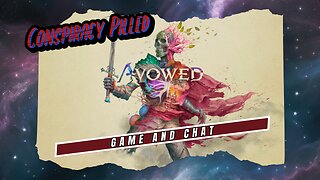Premium Only Content

Einstein's Extraordinary Prediction Over 100 Years Ago Now Proven True
Gravitational Waves Detected, Confirming Einstein’s Theory. A team of scientists heard and recorded the sound of two black holes colliding a billion light-years away, a fleeting chirp that fulfilled the last prediction of Einstein’s general theory of relativity. That faint rising tone, physicists say, is the first direct evidence of gravitational waves, the ripples in the fabric of space-time that Einstein predicted a century ago. (Listen to it here.) It completes his vision of a universe in which space and time are interwoven and dynamic, able to stretch, shrink and jiggle. And it is a ringing confirmation of the nature of black holes, the bottomless gravitational pits from which not even light can escape, which were the most foreboding (and unwelcome) part of his theory.
More generally, it means that a century of innovation, testing, questioning and plain hard work after Einstein imagined it on paper, scientists have finally tapped into the deepest register of physical reality, where the weirdest and wildest implications of Einstein’s universe become manifest.
Conveyed by these gravitational waves, power 50 times greater than the output of all the stars in the universe combined vibrated a pair of L-shaped antennas in Washington State and Louisiana known as LIGO.
If replicated by future experiments, that simple chirp, which rose to the note of middle C before abruptly stopping, seems destined to take its place among the great sound bites of science, ranking with Alexander Graham Bell’s “Mr. Watson — come here” and Sputnik’s first beeps from orbit.
“We are all over the moon and back,” said Gabriela González of Louisiana State University, a spokeswoman for the LIGO Scientific Collaboration, short for Laser Interferometer Gravitational-Wave Observatory. “Einstein would be very happy, I think.”
Members of the LIGO group, a worldwide team of scientists, along with scientists from a European team known as the Virgo Collaboration, published a report in Physical Review Letters on Thursday with more than 1,000 authors.
“I think this will be one of the major breakthroughs in physics for a long time,” said Szabolcs Marka, a Columbia University professor who is one of the LIGO scientists.
“Everything else in astronomy is like the eye,” he said, referring to the panoply of telescopes that have given stargazers access to more and more of the electromagnetic spectrum and the ability to peer deeper and deeper into space and time. “Finally, astronomy grew ears. We never had ears before.”
Long-Awaited Triumph
The discovery is a great triumph for three physicists — Kip Thorne of the California Institute of Technology, Rainer Weiss of the Massachusetts Institute of Technology and Ronald Drever, formerly of Caltech and now retired in Scotland — who bet their careers on the dream of measuring the most ineffable of Einstein’s notions.
“Until now, we scientists have only seen warped space-time when it’s calm,” Dr. Thorne said in an email. “It’s as though we had only seen the ocean’s surface on a calm day but had never seen it roiled in a storm, with crashing waves.”
The black holes that LIGO observed created a storm “in which the flow of time speeded, then slowed, then speeded,” he said. “A storm with space bending this way, then that.”
The chirp is also sweet vindication for the National Science Foundation, which spent about $1.1 billion over more than 40 years to build a new hotline to nature, facing down criticism that sources of gravitational waves were not plentiful or loud enough to justify the cost.
“It’s been decades, through a lot of different technological innovations,” France Córdova, the foundation’s director, said in an interview, recalling how, in the early years, the foundation’s advisory board had “really scratched their heads on this one.”
Word of LIGO’s success was met by hosannas in the scientific community, albeit with the requisite admonishments of the need for confirmation or replication.
“I was freaking out,” said Janna Levin, a theorist at Barnard College at Columbia who was not part of LIGO but was granted an early look at the results for her warts-and-all book about the project, “Black Hole Blues,” to be published this spring.
Robert Garisto, the editor of Physical Review Letters, said he had gotten goose bumps while reading the LIGO paper.
Music: Hello Moon by Dhruva Aliman
Amazon- https://amzn.to/3eLFy0P
https://music.apple.com/us/artist/dhruva-aliman/363563637
https://dhruvaaliman.bandcamp.com/album/hello-moon
http://www.dhruvaaliman.com/
Spotify - https://open.spotify.com/artist/5XiFCr9iBKE6Cupltgnlet
-
 52:51
52:51
Seeker Land
3 days agoMystery of the Ancient Druids - Lost Celtic Mystics - Full Documentary
1171 -
 0:59
0:59
Kellypowell63
3 years agoOver the years
34 -
 LIVE
LIVE
Steven Crowder
1 hour ago🔴 False Reality: What Joy Reid's Firing Exposes About The Left
49,359 watching -
 LIVE
LIVE
Bannons War Room
7 days agoWarRoom Live
18,065 watching -
 LIVE
LIVE
VSiNLive
25 minutes agoA Numbers Game with Gill Alexander | Hour 1
178 watching -
![🔴[LIVE TRADING] More Market Pain Incoming?! || The MK Show](https://1a-1791.com/video/fwe2/9d/s8/1/Z/V/o/i/ZVoiy.0kob.2-small-LIVE-TRADING-More-Market-Pa.jpg) LIVE
LIVE
Matt Kohrs
8 hours ago🔴[LIVE TRADING] More Market Pain Incoming?! || The MK Show
2,103 watching -
 39:37
39:37
BonginoReport
4 hours agoCrybaby Crenshaw’s Latest Meltdown (Ep.147) - 02/25/2025
44K121 -
 LIVE
LIVE
Wendy Bell Radio
5 hours agoThe Party's Over
12,722 watching -
 LIVE
LIVE
Randi Hipper
36 minutes agoBitcoin CRASHES to 3 month low! Crypto investors BEWARE
76 watching -
 LIVE
LIVE
Conspiracy Pilled
11 hours agoAvowed
73 watching